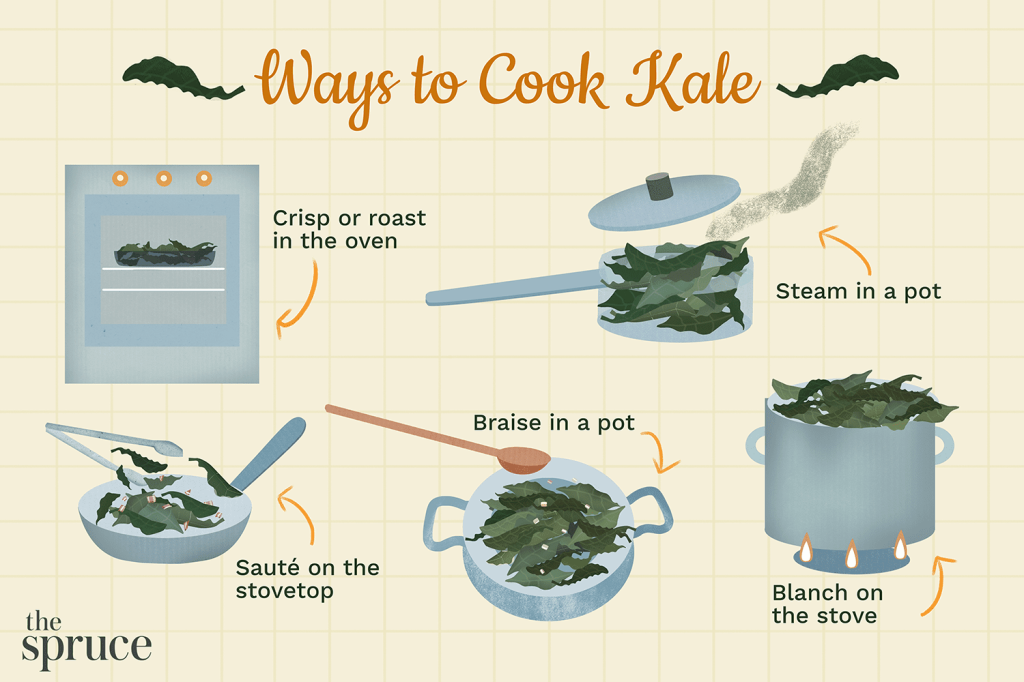Unlock The Flavor: Discover Exquisite Methods Of Cooking Kale Now!
Methods of Cooking Kale
Introduction
Hello Readers,
Welcome to our article on the different methods of cooking kale. Kale is a highly nutritious leafy green vegetable that is known for its many health benefits. In this article, we will explore various cooking techniques that can be used to prepare kale in a delicious and healthy way. Whether you are a kale lover looking for new recipes or someone looking to incorporate this superfood into your diet, we’ve got you covered. So, let’s dive in and discover the best ways to cook kale!
1 Picture Gallery: Unlock The Flavor: Discover Exquisite Methods Of Cooking Kale Now!

Steaming Kale
🌿 Steaming kale is a popular and healthy cooking method that helps retain its nutritional value.
Kale can be steamed by placing it in a steamer basket over boiling water. Cover the pot and steam for about 5-7 minutes until the kale is tender and bright green. Steamed kale can be served as a side dish, added to salads, or used as a topping for soups and stews.
Benefits of Steaming Kale
Steaming kale helps to preserve its vitamins and minerals, making it one of the healthiest ways to cook this nutritious green. Steaming also helps to soften the kale leaves, making them easier to chew and digest.
Disadvantages of Steaming Kale

Image Source: thespruceeats.com
One disadvantage of steaming kale is that it can result in a slightly bland taste. However, this can be easily overcome by adding flavorful seasonings or dressings to enhance the taste.
Sautéing Kale
🍳 Sautéing kale is a quick and easy method that adds a delicious flavor to this leafy green.
To sauté kale, heat some olive oil in a pan over medium heat. Add minced garlic and sauté for a minute until fragrant. Then, add the kale leaves and cook for about 5-7 minutes until they are wilted. Season with salt, pepper, and any other desired spices.
Benefits of Sautéing Kale
Sautéing kale brings out its natural flavors and results in a slightly crispy texture. This method also allows for the addition of various ingredients such as onions, mushrooms, or bacon, to create a more flavorful dish.
Disadvantages of Sautéing Kale
One disadvantage of sautéing kale is that it requires constant attention and stirring to prevent burning. Additionally, the high heat used in sautéing can cause some of the nutrients in kale to be lost.
Baking Kale Chips
🍟 Baking kale into crispy chips is a popular and healthy snack option.
To make kale chips, preheat the oven to 350°F (175°C). Remove the stems from the kale leaves and tear them into bite-sized pieces. Toss the kale with olive oil and seasonings of your choice, such as salt, pepper, or paprika. Spread the kale on a baking sheet and bake for about 10-15 minutes until crispy.
Benefits of Baking Kale Chips
Baking kale chips is a great way to enjoy a crunchy snack while still getting the nutritional benefits of kale. It is a healthier alternative to traditional potato chips and can be seasoned according to personal taste preferences.
Disadvantages of Baking Kale Chips
One disadvantage of baking kale chips is that they can easily burn if left in the oven for too long. It is important to keep a close eye on them while baking to prevent them from turning bitter and charred.
Boiling Kale
🍲 Boiling kale is a simple method that softens the leaves and can be used in various dishes.
To boil kale, bring a pot of water to a boil and add the kale leaves. Boil for about 5-7 minutes until the leaves are tender. Drain the kale and rinse with cold water to stop the cooking process. Boiled kale can be used in soups, stews, or as a side dish.
Benefits of Boiling Kale
Boiling kale helps to soften the leaves and reduce their bitterness. It also allows for the removal of any dirt or impurities that may be present on the leaves.
Disadvantages of Boiling Kale
One disadvantage of boiling kale is that some of its water-soluble vitamins, such as vitamin C, can be lost in the cooking process. However, the broth or cooking liquid can still retain some of these nutrients, so it is beneficial to use it in other dishes.
Grilling Kale
🔥 Grilling kale adds a smoky flavor and a slightly crispy texture to this nutritious green.
To grill kale, preheat the grill to medium-high heat. Brush the kale leaves with olive oil and season with salt and pepper. Place the kale on the grill and cook for about 2-3 minutes per side until it becomes slightly charred. Grilled kale can be served as a side dish or added to salads.
Benefits of Grilling Kale
Grilling kale enhances its flavor by adding a smoky taste and a touch of char. It also creates a delicious contrast between the crispy exterior and the tender interior of the leaves.
Disadvantages of Grilling Kale
One disadvantage of grilling kale is that it requires a grill or grill pan, which may not be available to everyone. Additionally, overcooking kale on the grill can result in burnt and bitter leaves.
Steamed Kale Salad
🥗 Steamed kale can be transformed into a tasty salad packed with nutrients.
To make a steamed kale salad, steam the kale using the method mentioned earlier. Once steamed, let it cool and then toss with your favorite salad ingredients such as cherry tomatoes, cucumbers, avocado, and a tangy vinaigrette dressing.
Benefits of Steamed Kale Salad
Steamed kale salad provides a refreshing and nutritious option for those looking to incorporate more leafy greens into their diet. It combines the health benefits of kale with the flavors and textures of other salad ingredients.
Disadvantages of Steamed Kale Salad
One disadvantage of a steamed kale salad is that the kale leaves can become soggy if not properly drained and dried after steaming. It is essential to remove any excess moisture to prevent a watery salad.
FAQs
1. Can I eat raw kale?
Yes, raw kale can be eaten and is often used in salads or smoothies. However, it is important to note that raw kale can be tough and slightly bitter. Massaging the kale leaves with lemon juice or olive oil can help soften them and improve the taste.
2. Which method of cooking kale retains the most nutrients?
Steaming kale is considered the best method for retaining its nutrients as it uses minimal water and cooking time. This helps to preserve the vitamins and minerals present in kale.
3. Are there any specific cooking methods for baby kale?
Baby kale is tender and can be enjoyed raw in salads or cooked using any of the methods mentioned in this article. However, since baby kale is more delicate, it requires less cooking time compared to mature kale.
4. Can I freeze cooked kale?
Yes, you can freeze cooked kale. After cooking, allow it to cool completely before transferring it to airtight containers or freezer bags. Frozen cooked kale can be stored for up to 3 months and used in soups, stews, or as a side dish.
5. Are there any alternative seasonings for kale?
Absolutely! Besides salt and pepper, you can experiment with various seasonings such as garlic powder, onion powder, paprika, cayenne pepper, or even soy sauce. These seasonings can add a burst of flavor to your kale dishes.
Conclusion
In conclusion, kale is a versatile and nutritious vegetable that can be cooked in various ways. From steaming to sautéing, baking to grilling, there are numerous methods to choose from depending on your taste preferences and desired texture. Each method offers its own unique flavors and benefits, allowing you to enjoy kale in different ways. So, don’t hesitate to explore and experiment with these cooking techniques to discover your favorite method of cooking kale. Incorporating kale into your diet can provide you with a wide range of health benefits and add a delicious twist to your meals. Start cooking kale today and reap the rewards of this superfood!
Final Remarks
Friends, we hope this article has provided you with valuable insights into the various methods of cooking kale. However, it is important to note that individual preferences and dietary needs may vary. It is always recommended to consult with a healthcare professional or nutritionist for personalized advice. Remember to source fresh and organic kale whenever possible to ensure the highest quality and nutritional value. Enjoy your culinary adventures with kale and embrace the goodness it brings to your plate. Bon appétit!
This post topic: Cooking Techniques

